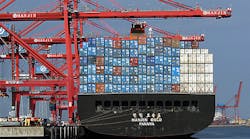Tariffs Are Poised to Wreck Christmas for Shipping Companies
Christmas is looking a little less bright for container-shipping companies.
As the industry enters what’s typically its busiest quarter before the year-end holidays, an escalating trade row between China and the U.S. may lead to higher prices for China-made goods from Christmas lights to cooking stoves. With about 90% of global trade carried by sea, that could mean a big dent on shipments.
The U.S. has proposed another $200 billion of Chinese goods that could face higher levies after increasing duties by 25% on some imports this month. The list is open for comments, with a hearing scheduled for August. In a worst-case scenario, world traffic could be reduced by almost 1%, or as many as 1.8 million 20-foot containers, due to the intensifying trade dispute, according to Drewry Shipping Consultants Ltd.
“The trade tensions and uncertainty on the economic outlook is limiting restocking demand as businesses have turned more cautious,” said Corrine Png, CEO of Crucial Perspective Pte., a Singapore-based research firm focused on transportation. “The U.S.-China tariff war will dampen trans-Pacific trade volume and freight rates, global trade flows and supply chains will shift.”
Coupled with higher fuel costs as oil prices in New York have risen around 10% this year, boxship operators may only break even at best after posting profits in 2017, according to Drewry. The charts below show the challenges in store for the container-shipping industry this year.
1. Trade Uncertainty
China’s new export orders fell in June to the lowest since February. This contrasts with growth in exports that could indicate companies shipped goods early to beat the first tariff increase, which took effect July 6. For the container-shipping industry, the best of volume growth for this year is likely over, Bloomberg Intelligence analyst Rahul Kapoor said.
2. Inflating Costs
Shipping firms worldwide face a $7 billion increase in total fuel costs in 2018 as oil prices climbed close to $80 this year, said Nilesh Tiwary, a Drewry analyst. Drewry now predicts a best-case scenario of box carriers breaking even this year, compared with a previous expectation for about $5 billion in operating profit. The increase in fuel prices is outpacing a recovery in freight rates.
3. Overcapacity
Container shipping lines have been struggling with overcapacity since the global financial crisis, which led to lower freight rates and the collapse of Hanjin Shipping Co. in 2016. While capacity will still exceed demand this year, the situation will be more balanced in 2019 as boxship operators have refrained from ordering new vessels.
By Kyunghee Park



